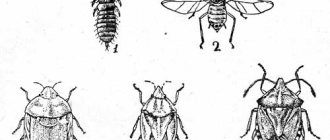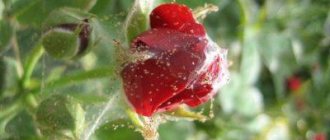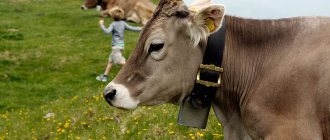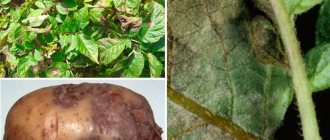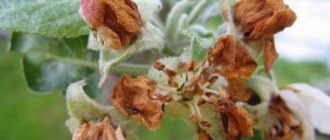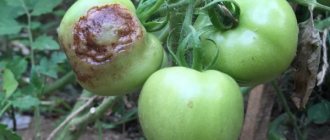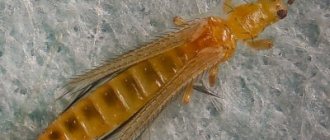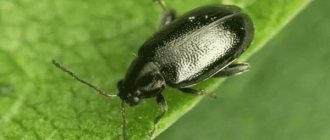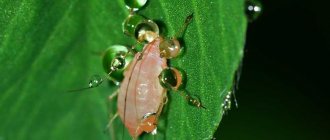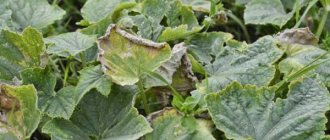Causes of brown spots on tree leaves
They are divided into two groups:
- internal;
- external.
In the first case, the disease occurs as a result of weakening of the body. External factors for the development of brown spot include various fungi from the genus Phyllosticta. Moreover, brown spot occurs not only on apples, but also on pears and quinces.
The pathogen begins to develop when suitable weather conditions occur. The weather outside should be warm and high humidity.
Winter is not terrible for fungi, since they can calmly wait out the cold season in order to infect as many plantings as possible next season with renewed vigor. Late blight and brown spot cannot exist together on the same plant.
Which tomato varieties are more resistant to brown spot?
According to reviews from gardeners who have encountered the presence of cdadosporiosis fungi in their greenhouses and garden plots, the hybrids of the Pink Paradise F1, Pink Magic F1, Pink Bush F1, Titanic F1, Fast and the Furious F1, Khrustik F1, Charisma F1, Bohemia F1 series are practically not susceptible to attacks brown spot spores.
In order for plants to demonstrate their genetic resistance to this disease, it is necessary to create conditions so that their immunity does not weaken.
Which tomatoes(tomatoes) are the most productive for open ground?
To do this, it is necessary not only to plant seeds and let them germinate. You should select fertile soil with an acidity in the range of 5.5-6.5 pH and add the necessary fertilizers.
The seedlings should not stretch out; young tomatoes are hardened before planting. When replanting, try not to damage the root system. Their further strength will depend on the condition in which tomato seedlings arrive at their permanent growing site and how they take root.
Drugs for protection
Spraying with fungicides or antibiotics will help solve the problem. There are many drugs that fight not only phyllosticosis.
"Raek"
The drug contains the active ingredient difenoconazole. Benefits of the fungicide:
- effect after the first use;
- rapid penetration into the plant;
- providing protection over a long period of time;
- slows down the formation of spores, making their germination impossible.
Raek is presented in the form of a liquid. 2 cubes of the drug are diluted in 10 liters of water. Spray an apple tree suffering from brown spot at the moment the buds open. The treatment procedure is repeated during the budding period.
See also
How to get rid of lichen on an apple tree, the best methods of control and preventive measuresRead
"Fitolavin"
You can fight phyllostictosis with the help of another equally effective medicine - Fitolavina. It is an antibacterial drug with fungicidal properties. The active substance is phytobacteriomycin.
The main advantage of Fitolavin is its wide spectrum of action, but there is also a drawback. As a result of use, the drug accumulates in plants and trees. Therefore, it is recommended to use if infestation has reached a large scale. Spraying is carried out long before harvest.
"Strobe"
The drug to combat phyllosticosis is part of the group of strobilurins. Benefits of the fungicide:
- acts systematically;
- distributed evenly over the entire sheet;
- the liquid on the leaves is not washed off by rain;
- continues to operate during temperature changes;
- destroys fungi and other pathogens.
Treatment of brown spot on apple trees with this drug can result in negative consequences for humans. Direct contact with skin and inhalation of vapors leads to the development of allergic reactions. If it is necessary to cure apple trees from brown spot, it is recommended to alternate Strobi with other drugs. This will prevent the development of fungal resistance.
Fungicide "Zato"
“But” for spraying deprives microorganisms of the opportunity to breathe. This causes the fungi to stop growing and die. It is used in rainy weather, as it is not washed off by wet streams.
This drug is recommended in cases where it is urgently necessary to take measures to combat fungi, especially if it is cold outside.
“But” is suitable for treating affected apple trees if the weather is constantly changing.
Brown spot disease
Cladosporiosis of tomatoes - treatment
Brown spot on tomatoes appears as yellow spots on the upper side of the leaves and a grey-brown coating, sometimes with a purple tint, on the underside. With severe damage, plaque forms on the surface of the leaves. As the disease progresses, the leaves turn brown and wither, but do not fall off. Tomato cladosporiosis can even affect flowers and fruits, although this is rare. A sick plant lacks strength to develop and produces a weak harvest.
Brown spot progresses at temperatures of 20-25 ºC and air humidity of 90% or higher. If you manage to raise the temperature to 25-30 ºC (this is not difficult to do in a greenhouse), and reduce the air humidity to 60%, the development of cladosporiosis will stop, but the affected leaves will have to be removed - they cannot be cured. You need to be careful when picking or trimming diseased leaves so as not to spray fungal spores. It is also necessary to remove fallen leaves, because they can also harbor spores.
As soon as you notice signs of the disease, do not hesitate for a minute. The fight against cladosporiosis is carried out with the drug Barrier, 8 g of which is dissolved in 10 liters of water and the plants are generously treated with this composition, moistening the leaves both on the upper and lower sides. Treatment of tomato cladosporiosis can also be carried out with the drugs Captan, Polychom, Tsineb, copper oxychloride and other fungicides, which can be easily purchased at any garden pavilion or flower shop, but try to use fungicides in strict accordance with the instructions.
The treatment is repeated after 7-10 days, but a month before the fruits ripen, spraying tomatoes with fungicides should be stopped. If the tomatoes still need treatment, treat them with less toxic folk remedies.
After harvesting, do not forget to remove the tops from the garden bed and dig up the soil. And try to grow tomato varieties that are resistant to cladosporiosis, for example, Nasha Masha, Vezha, Centaur, Red Comet.
- Anthracnose: treatment and prevention, control measures
Cladosporiosis of cucumber
Brown spotting of cucumbers usually appears in the second half of summer, but it affects not only the leaves and shoots, but also the fruits - ulcers with plaque form on the cucumbers, and they become unsuitable for food. Most often, cladosporiosis of plants develops in greenhouses - its pathogens persist in the soil and plant debris for 2-3 years. If you were careless and did not put things in order in the greenhouse before planting the seedlings, the disease will make itself known as soon as conditions suitable for it arise - high humidity, drafts, frequent drops in temperature and sprinkling watering.
As soon as you see signs of brown (olive) spot on cucumbers in a greenhouse, stop watering for several days, ventilate the greenhouse and remove the affected parts of the plant. If you find a disease in the garden bed, then you need to remove not only diseased leaves, but also excess leaves. If the cause of the disease is cold weather, cover the cucumbers for a while.
Treatment of cladosporiosis on cucumbers is carried out with the same preparations as on tomatoes - copper-containing fungicides. For better “sticking” of the drug to the plant, add a little liquid soap or dishwashing detergent. Treatment against cladosporiosis is carried out in two stages with an interval of 7-10 days.
Brown spot on carrots
Brown spotting of carrots is called “alternaria blight” - after the name of the causative agent of the disease Alternaria dauchi. Alternaria blight can reduce carrot yields by 35-50%. Spotting is detected even at seedlings: dark brown constrictions form on the stems at soil level. Young carrots may die immediately. If the disease develops on adult plants, it affects the leaves, petioles and stems - first, brown spots with a dark border appear on them, then the leaves curl, and the plants look like they have been scalded with boiling water.
In some cases, Alternaria also affects root crops - small light brown spots of rot appear on them, which penetrates deeply into the fruit.
How to deal with brown spot on carrots? Combining preventive measures and directly treating the crop against Alternaria. Necessary:
- grow disease-resistant varieties and hybrids;
- carry out thermal disinfection of seed material;
- add increased doses of potassium and phosphorus to the soil, especially if you grow carrots on loamy soils;
- observe crop rotation;
- At the end of the season, remove plant debris from the site and dig up the soil.
To destroy the causative agent of brown spot on carrots, at the first signs of the disease you detect, double treat the crop with Quadris or Bravo with an interval of 7-10 days.
Brown spot of strawberries (strawberries)
Strawberry brown spot disease (marsoniosis) affects almost all varieties of the crop. Bushes infected with this disease develop poorly and eventually die. The first sign of the disease is the appearance of brown or purple spots on old leaves, which gradually spread over the surface. As a result, the leaves dry out and die, and during rain, pathogenic spores drain from them along with water and are scattered throughout the garden bed.
If you notice signs of brown spot, carefully cut out the diseased leaves, being careful not to shake off the fungal spores. It is better to destroy severely affected bushes entirely, leaving only a couple of young leaves that need to be treated with a fungicide. The fight against brown spot on strawberries is carried out by double treating the area with the fungicide Euparen - before flowering and after harvesting. This drug does not dissolve well in water, so mix it thoroughly, let it stand, then shake again and carefully drain so that undissolved particles remain in the bucket.
The fungicide against brown spot Gamair has proven itself well. For preventive purposes, you can resort to treating strawberries in the fall with Ordan, Falcon, Rovral, Bravo, Horus, Ridomil, Metaxil, Bordeaux mixture, copper sulfate or copper oxychloride in strict accordance with the instructions.
Brown spot of apple and pear trees
Brown spot (in this case, phyllosticosis) affects the leaves of apple, quince and pear trees, as well as raspberries. The spots that form on the leaves of fruit trees as a result of the disease are similar to scab spots, but without a velvety coating. In the fight against phyllosticosis, it is necessary to remove diseased and fallen leaves and burn them, and treat the affected plants before and immediately after flowering with a one percent solution of Bordeaux mixture or copper sulfate. If you have treated trees for scab, you no longer need to spray them against phyllosticosis.
Phyllosticosis is very similar to another fungal disease of fruit trees - coccomycosis. It is also manifested by the appearance on the leaves of brown or reddish spots with a diameter of no more than 2 mm, but a white or pinkish coating forms on the underside of the leaves. And coccomycosis often affects not apple and pear trees, but cherries and cherries, but it is better to play it safe and treat the trees with anti-scab preparations after flowering.
Brown spot on walnut
Marsoniosis (brown spot) of walnut affects leaves and shoots during periods of prolonged rains, when air humidity is unusually high. Marsoniosis is most dangerous during the flowering period - it can destroy almost all flowers. Brown spot also affects nut fruits. In the fight against brown spot on nuts, the tree is treated in early spring, even before the start of sap flow, with three percent Bordeaux mixture. Then treatments with a one percent preparation should be carried out during leaf regrowth and again two weeks later.
Folk remedies
In addition to chemicals, it is worth paying attention to the products that are at hand. Common and most popular recipes for combating brown spot:
- A solution containing 20 drops of iodine, 5 liters of water and 500 ml of milk.
- 1 liter of serum per bucket of water.
- Decoction of coal ash - 10 liters of water and 500 g of ash. The mixture is boiled for 25 minutes.
- Potassium permanganate solution. Potassium permanganate is added to a bucket of water in such an amount that the liquid becomes light pink.
- 500 g of crushed cloves of garlic and arrows of a green plant, infused in 10 liters of water.
All recipes should result in liquid. The prepared solution is sprayed onto infected apple trees. To prepare them you will need simple ingredients.
Disease prevention
Consists of many activities. Gardeners sometimes underestimate the importance of tree pruning. Sanitary removal of branches is necessary, since the affected ones are also destroyed along with the dry ones. Healthy branches should also be pruned to thin them out to provide more space.
See also
How often should you water apple trees in the summer and during the period of fruit ripening, frequency and periodicityRead
Pruning for the purpose of thinning has a beneficial effect on the processes of photosynthesis in apple tree leaves, increasing them. This is also useful, as the ventilation of the crown branches increases. The sparse structure of the apple tree guarantees that much fewer foci of infection will form. Direct access of sunlight to the branches kills the remaining fungus.
To protect apple trees from brown spot, be sure to destroy fallen leaves. There are several ways to do this. Fallen leaves are used to make compost or simply buried in a trench. To make them easier to work with, they are burned.
What it is?
Brown spot is a fungal infection (also called leaf mold) that affects plants both in open ground and in greenhouses and conservatories. Typically, such phytopathologies have a specific pathogen - a fungus of a certain type. However, the specificity of this disease is that individual crops are affected by different pathogenic organisms. All of them tolerate wintering well in fallen leaves and can live in the soil for several years, remaining inactive. Varieties:
- anthracnose (gooseberries and black currants are primarily affected, and the pathogen does not disdain many other fruit, berry and flower crops in the garden);
- ascochyta blight (alfalfa, chrysanthemum, clematis);
- cladosporiosis (peony);
- marsoniosis (rose, strawberry, wild strawberry, walnut, poplar, birch);
- phyllosticosis (apple, pear, raspberry, quince, lilac, hosta, chestnut, rowan, elm, maple, hawthorn, ash, rhododendron);
- cercospora blight (rose).
Infection period: fungal activity begins in April and subsides only by August. Consequences: in the absence of timely treatment, it can lead to loss of almost 50% of the crop. Features of the course: fungi that are the causative agents of brown spot and late blight cannot coexist. Therefore, diseases are mutually exclusive.
For reference. Plants can get sick with a variety of spots - black and white, red and purple, gray and yellow, etc. In most cases, the treatment regimen is the same - spraying with universal fungicides. However, it is still worth familiarizing yourself with the peculiarities of the course of the disease in order to differentiate the effect of fungi. After all, one can destroy a plant in a month, and the second will undermine its vitality for several years. Or fruits with some infections are dangerous to human health, while others are completely harmless.
Chemical treatment
The drugs that are used to control apple trees are also used as prophylaxis. The only difference is the dilution of smaller doses. Treating healthy leaves will eliminate the likelihood of disease development.
It is advisable to spray with chemicals after harvesting - in the fall. There is no need to postpone the procedure until spring. If the apple trees feel healthy before the onset of cold weather, this will help avoid the development of the disease in the new season. The leaves of the tree will not become stained, and the person will be able to harvest.
FAQ
In the process of growing apple trees, gardeners often encounter situations that go beyond the normal development of the plant. Let's try to understand the causes of the most frequently occurring problems.
Why does the apple tree not bear fruit or bloom?
This problem can have several causes.
- If this is a young tree, perhaps the time for fruiting has simply not come. Some varieties enter this period 7-9 years after planting.
- An unregistered seedling was purchased. The conditions of the region are not suitable for it; the tree directs all its strength to survival. There are no more of them left for fruiting.
- The same situation arises when a seedling is planted in an inappropriate place - swampy, close to groundwater, alkalized, saline, too acidic soils.
- Insufficient or unbalanced nutrition. For example, excess nitrogen, lack of phosphorus and potassium.
- Damage to buds by flower beetle.
- Freezing of flower buds.
Why do apples rot on trees?
Apples rotting on a tree are the result of moniliosis, scab, and bacteriosis. And also the most common cause of the problem is an attack by pests - codling moth, copperhead, flower beetle.
Video: fruit rot
Black rot on an apple tree
The probable cause is black cancer, bacteriosis.
Mold (fungus) on an apple tree
This problem often appears in dense, shaded, damp places. Mold-like formations appear on the tree bark. They may be fungal in nature. In this case, the fungus can grow into the bark, destroying it. It doesn’t matter exactly what the fungus is called, the actions are as follows:
- It is necessary to clean the bark, cut out damaged areas to make healthy wood.
- Treat wounds with fungicides - 3% solution of copper sulfate, 3% solution of Bordeaux mixture, Abiga-Peak, etc.
- Apply a protective layer of garden varnish.
But often mosses and lichens look like mold. The tree bark is just a platform for them to live. They can just as easily live on a rock. Mosses and lichens have no roots and do not damage the bark. The phenomenon is undesirable, but not fatal. Scrape them off with wooden scrapers, being careful not to damage the bark. Film, paper, fabric, etc. are first spread on the ground. Then they are washed with a 1% solution of copper sulfate and whitened with lime mortar.
Prevention of the problem:
- Avoid dense plantings.
- Do not allow the garden to become overgrown with weeds.
- Regulatory crown pruning is carried out annually.
- In the fall, the bark of trunks and thick branches is peeled and whitened with lime mortar.
Why do apples fall
This is a fairly common phenomenon that every gardener has encountered at least once. Apples can fall at different stages of development - from ovaries to fully ripened fruits. There may be various reasons for this:
- Lack of moisture. In this case, first of all, the tree gives it to the leaves, taking it from the fruits that fall.
- Excess moisture prevents the roots from being saturated with oxygen. As a result, the nutritional process of the fruit is disrupted.
- Lack of phosphorus and potassium can also cause apples to fall off. It is necessary to maintain a balanced diet.
- Excess nitrogen makes the fruits loose and some of them fall off.
- Natural normalization of the yield. With abundant flowering and formation of ovaries, the apple tree is able to grow only 5-10% of them, and discards the excess. This is fine.
- In some varieties, fruits that have reached removable maturity fall off. The gardener must know this feature and harvest the crop in a timely manner.
- Damage by pests, for example, codling moth.
Why do apple tree leaves turn yellow?
Possible reasons for this phenomenon are varied:
- The tree was planted in a flooded, swampy area, or the gardener was overzealous with watering. When there is an excess of moisture, the leaves begin to turn yellow from the top of the tree.
- When planting, the root collar was buried - the result was the same.
- Lack of nitrogen - leaves begin to turn yellow starting from the lower tiers.
- Lack of zinc, magnesium, iron, sulfur. In such cases, spraying with solutions of complex fertilizers containing the indicated elements gives a quick effect.
Lack of various micro and macroelements causes yellowing of leaves
- Hot weather and lack of moisture.
- Damage to roots by moles.
- Fusarium.
Red spots on apple leaves
The appearance of red spots on the leaves may indicate infection with rust or scab, as well as infestation with gall aphids. With a lack of potassium, the edges of the leaves may turn red. Magnesium deficiency causes redness of the interveinal space.
Brown spots on apple leaves
Such signs may indicate infection with phyllosticosis (brown spot). In addition, a copper deficiency is possible, but this is unlikely if the gardener regularly treats the crown with solutions of copper sulfate or Bordeaux mixture. Another option is leaf burn as a result of sprinkling watering in hot sunny weather. In this case, drops of water on the leaves play the role of lenses that enhance the impact of sunlight.
Apple tree leaves turn red and curl
Most likely, the apple tree is affected by gall aphids. This is easy to check - just unroll the curled sheet. If there are no aphids in it, perhaps this phenomenon is a consequence of a deficiency of phosphorus, magnesium or manganese. Also, the trunk could have been severely compressed when installing the hunting belt, which limited the nutrition of the crown.
How to fight black plaque on an apple tree
As a rule, the black coating is the excrement of sooty fungus. It can also be symptoms of bacteriosis or black cancer. The methods of struggle are described above.
Why didn't the leaves fall on the apple tree in the fall?
This phenomenon is not harmless - it can cause a decrease in the tree’s winter hardiness, productivity and life expectancy. There may be several reasons:
- The tree is overfed with nitrogen in the second half of summer or autumn. This causes a new wave of leaf growth that simply does not have time to ripen.
- Excessive watering or too rainy autumn. It should be remembered that pre-winter moisture-charging watering is needed once, in late autumn. But the rest of the autumn time after harvesting, the tree does not need watering.
- Unregistered apple variety. If you plant a southern variety in the middle zone, then such a tree will not have time to complete the growing season by winter.
Apple tree leaves froze in spring
If only the leaves are frozen, it’s okay. New ones will grow. It is much worse if the wood is damaged. This usually manifests itself in the fact that the tree woke up late after winter, then seemed to recover, but the leaves became small and in the spring they grow later than usual. The effects of freezing appear over the next 3-4 years. You can check the extent of the damage by cutting the weak branches. Dark areas on the cut indicate frost damage in these places. The affected areas can no longer recover, but with proper care the tree can live for another 6-8 years. During this time, you can grow a new apple tree. Proper care means anti-aging pruning, increased watering and fertilizing of the tree.
What are tops on an apple tree?
Tops are highly fattening vertical shoots. The leaves on them are always very large, sparsely spaced. Such shoots never bear fruit. The tops take away food from the tree and therefore must be removed. They appear after the tree has been pruned too hard. If necessary, some tops can be made fruit-bearing. To do this, they are cut to two or three buds. A new fruiting branch can be formed from a second-order branch. Such branches need to be bent to a horizontal level, since vertical ones never bear fruit.
Tops are highly fattening vertical shoots
Treatment of black hollow in an apple tree
A black hollow forms on an apple tree as a result of black cancer. To treat it, you first need to thoroughly clean the hollow of dead wood and bark. To do this, you may need various tools - a knife, a chisel, a drill with a wire attachment, etc. Before starting work, you should spread a film or other suitable material under the tree to collect all the waste being removed. After the operation, they must be burned, as they are a source of infection.
After cleaning the hollow, it should be disinfected with a 2% solution of copper sulfate and allowed to dry for several hours. The surface of the hollow is covered with a layer of garden varnish prepared on the basis of natural ingredients (beeswax, lanolin). You cannot place garden varnish made from petrolatum or containing other petroleum products into the hollow. At the end of the operation, the hollow is filled with polyurethane foam. Previously, cement-sand mortar was used for these purposes, but modern materials give better results. After 2-3 days, excess foam is cut off with a sharp knife.
Video: super putty for treating cuts, wounds, hollows
It is safe to say that most of the problems associated with diseases or pests of apple trees are caused by gardeners due to failure to comply with basic preventive measures. Other problems occur due to non-compliance with agricultural technology, incorrect selection of varieties and choice of planting location. With a proper systematic approach to growing and caring for an apple tree, you can always count on a decent result.
- Author: Pyotr Vladimirovich Sadovnikov
Hello! My name is Pyotr Vladimirovich. I am 63 years old. By education, he is a mechanical engineer. Rate this article:
- 5
- 4
- 3
- 2
- 1
(17 votes, average: 4.4 out of 5)
Share with your friends!
Fertilizers and pests
Feeding apple trees plays an important role. But even during such an event, a person can make a mistake. It is necessary to observe the dosage of the components of the fertilizer that is introduced. To increase the resistance of fruit trees to brown spot, the presence of nitrogen in fertilizers is mandatory.
Another preventive measure against brown spot is the destruction of insects. Pests suck the sap from the tree, thus transmitting the infection. Thrips and aphids are especially dangerous.
What to do with the harvest
At an advanced stage of the disease, the most aggressive fungicides are used. If treatment with solutions occurs shortly before harvest, it is better to refrain from eating the fruits. Spraying is not abandoned even in the fall, as this will ensure fruiting of the apple tree next year.
Apples can be eaten if treated with fungicides long before they were harvested. Over time, they get rid of accumulated harmful substances. That is why apple trees are sprayed during the budding period.
If no measures are taken, a person may lose half of his garden harvest. Fallen apples, as well as leaves, are disposed of. Fruits can carry a source of infection, which will cause the disease to appear next year.
Symptoms and external signs
Cladosporiosis develops gradually; the disease can be recognized during flowering and fruit formation. Already in July, you can see characteristic light spots on the leaves; a change in their color to brown indicates the beginning of the process of withering of the plant.
If treatment is not started, the surface of the leaf thickens and becomes velvety to the touch. Then the green mass of the plant falls off, which affects the process of fruit formation.
Description of the stages of disease development:
- Initial - symptoms appear during flowering. Light green spots appear on the outside of the leaf, and a light gray coating forms on the inside.
- Progressive - the upper leaves are affected, but the stem and fruits remain intact. The surface of the leaf becomes denser, becomes velvety, and the green mass of the plant loses its shape and color. The spots on the leaves darken and become brown; their more intense color is observed on the inner surface of the leaf.
- Active - leaves fall, the plant withers, the fungus attacks the fruits. No method can save seedlings.
